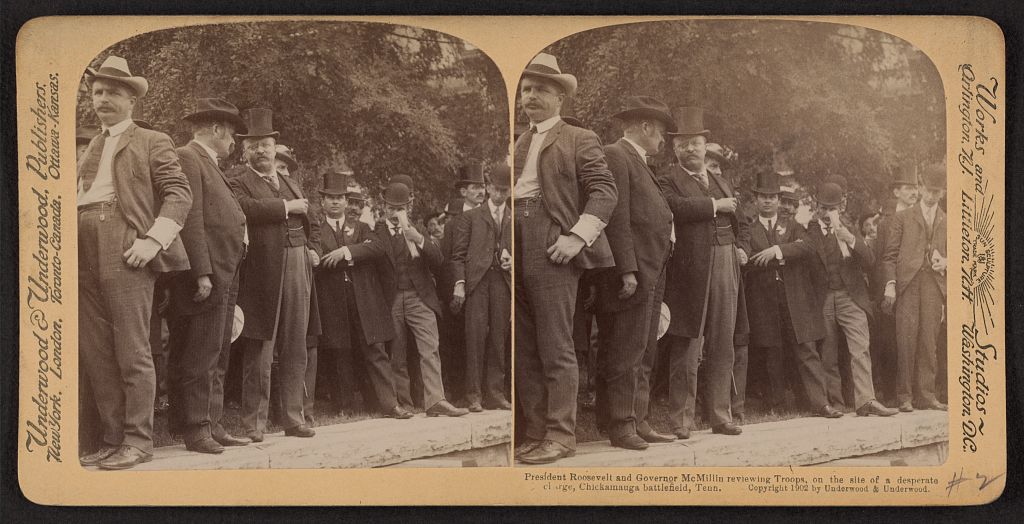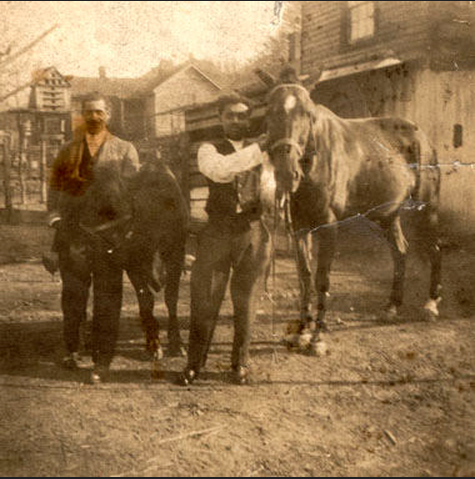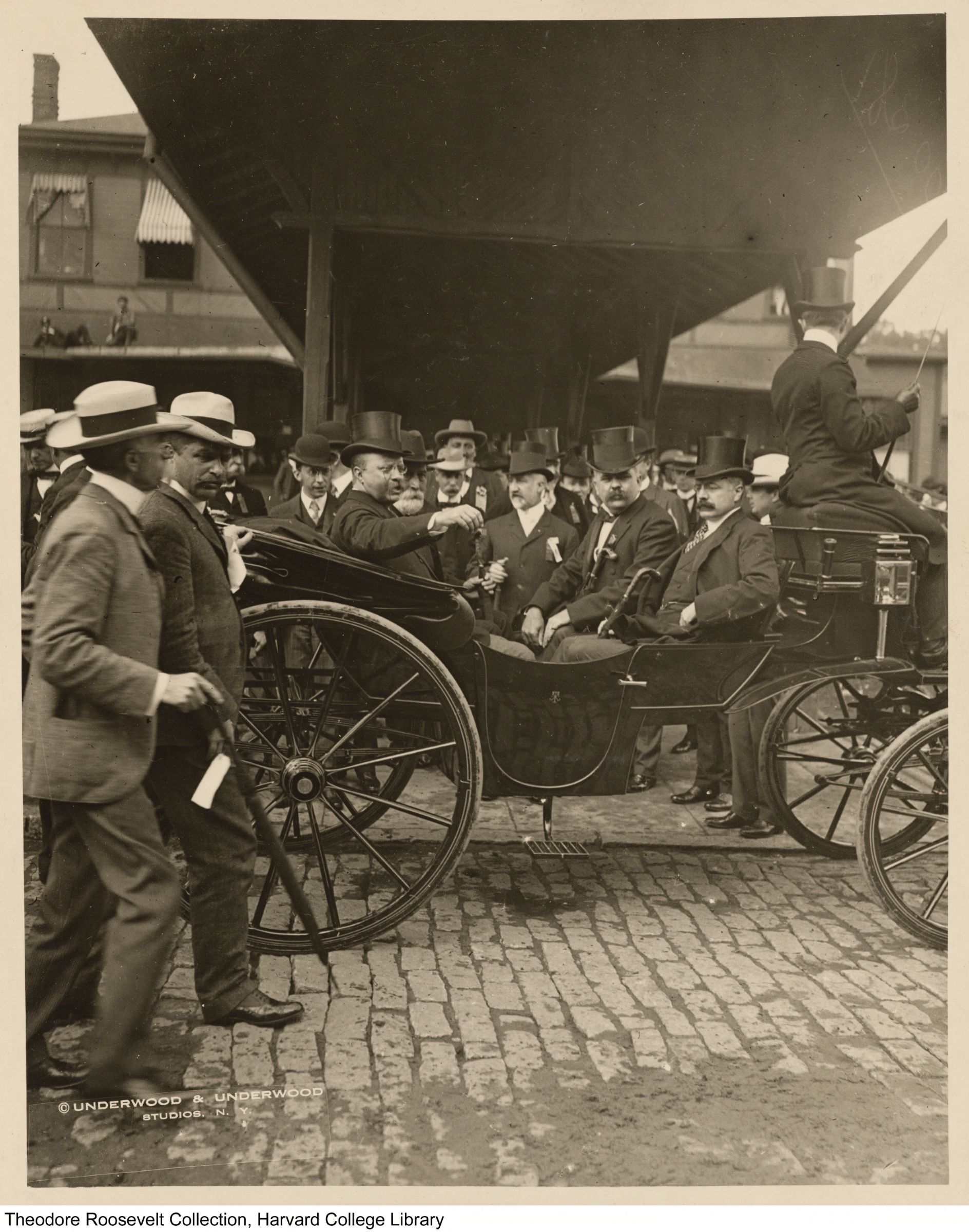


An important correction, in light of additional evidence, about the misidentification of Isaac Dickson in historic photographs with Theodore Roosevelt
Above: bodyguard Frank Tyree, at left, with President Theodore Roosevelt while he reviews the Chickamauga battlefield, 1902. New evidence has led local researchers and historians to identify this as a man previously believed by some to be Isaac Dickson in photographs of Roosevelt’s visit as Tyree. From the Library of Congress.
Late last year, local writer and photographer Jen Bowen, who was writing a piece on President Theodore Roosevelt’s 1902 visit to Asheville for the Blade, and noticed a figure standing near the President in photos of his visit in the Theodore Roosevelt Collection. She noticed a resemblance to photos of local black politician and businessman Isaac Dickson she was also examining at the time, and believed they might be the same person.
In an effort for further verification, the Blade contacted Darin Waters, a professor at UNCA and one of the foremost experts on the history of African-Americans in WNC, especially in the period after the Civil War.
Waters was initially uncertain, though he thought it might be Dickson. Bowen later found additional images of the same person at Roosevelt’s visit, and those too were sent to Waters for review.
Dickson was a major figure in Asheville’s history, helping to found the school system and local institutions like the YMI. At one point, part of the predominantly African-American section of downtown was even named “Dicksontown.”

Isaac Dickson with his nephew, James Wilson, in front of his home at 133 Valley Street. Heritage of Black Highlanders Collection, UNC-Asheville Ramsey Library
Waters concluded, after reviewing the additional images, that he believed the photos were of Dickson, based on the earlier known photos of him and the political situation at the time. Such a place near Roosevelt, but to the side of the main delegation, he believed, also made some sense given that African-Americans were still a key part of the national Republican coalition at the time, and Roosevelt had black leaders that he consulted with, including in the South.

Roosevelt’s welcoming party leaving the depot and heading possibly to the Biltmore Estate to take photos before to Court Square (now Pack Square) for the speech. The man in the foreground by the President’s side accompanying his carriage and looking down towards the camera was misidentified as Isaac Dickson, but is now believed to be bodyguard Frank Tyree. Theodore Roosevelt Collection, Houghton Library, Harvard University
The Blade ran a piece shortly after Waters completed his verification, citing the apparent discovery.
But in late June, researchers from Pack Library’s North Carolina Collection, which specializes in local history, contacted the Blade, saying that they had reviewed further evidence and came to a different conclusion: that the person in question was instead a bodyguard named Frank Tyree. After seeing some of the initial photos presented by Bowen, they continued their research and found photos of a very similar-looking man beside Roosevelt at the Chickamauga battlefield and at other functions as well.
Earlier this week, after completing a review of the evidence they had presented, Waters said that he agreed with the librarians’ assessment: the figure is Tyree, and not Dickson.
A question of identity
“We had really hoped it was Dickson,” North Carolina Collection Librarian Zoe Rhine tells the Blade, but after seeing some of the initial photos Bowen found they had their doubts, and delved into the issue further. Eventually, they found images of Tyree, a bodyguard who looked very similar to the figure identified as Dickson, and in one image was even wearing similar clothes and hat. “We kept digging and found evidence it was Tyree.”
In June, Pack’s researchers contacted Bowen and, shortly after, the Blade, with photos of Tyree. On June 22 I met with Rhine to review the evidence. The next day, I contacted Waters, who was then out of town. On July 1, after his return, I delivered the material the library’s researchers had uncovered to him for further review, to see what he made of it and if his assessment of the man’s identity had changed.
Roosevelt’s visit came at a key time in a changing city and country. At the time, Waters notes, while many of their rights were taken away by the racist Jim Crow regimes throughout the South, including in North Carolina, African-Americans still formed a key part of the Republican coalition nationwide. Roosevelt in particular consulted with both local and national African-American leaders in some circumstances, a factor Waters had cited in his belief that the person was Dickson.
At the same time, the time was marked by severe racism and white supremacy, and the proximity of an African-American leader to the President would have been highly controversial, as it was when Roosevelt had invited Booker T. Washington to the White House about a year before his visit to Asheville.
After completing his review of the additional information and images, Waters agreed with the librarians’ conclusions.
“There are striking similarities between the two,” Waters tells the Blade after comparing the images of Tyree and Dickson. “I think it is the bodyguard, there are very few references to him I found.”
“Dickson was mixed race, he was more fair-skinned than dark-complexioned, and that man could have clearly been,” he adds.
“It has to be stressed too that Dickson was definitely well-positioned to be kind of one of the people that Roosevelt would have had a relationship with,” Waters says. “He had relationships like that with a number of African-Americans who were seen as leaders within the community. At the time most African-Americans are still within the Republican party, that transition hadn’t been made yet.”
“At one point they tried to establish a Republican club at the YMI, and [Dickson] was one of the people who was part of that effort.”
Waters notes that this kind of difficulty in identifying figures in older photographs is not uncommon, and that the stories in the past are often changing as new evidence emerges.
“It shows how important it is, in these cases, to have corroborating evidence,” he says. “The past is not fixed, it is fluid, it’s always changing based on new evidence that’s coming along, and even in some cases, if there’s not new evidence, the evidence can be interpreted in a different way. That can end up with a completely different narrative than you had before.”

A later image of Tyree, after his stint as one of Roosevelt’s bodyguards. Date unknown. Library of Congress.
After reviewing the evidence, Bowen has also changed her mind, and agrees with the assessment of the person in the photo as Tyree. While she says that there is some disappointment, she’s also glad that the figure’s identity is now accurately identified, and that there is more focus on Dickson’s important role in Asheville’s past.
“History is produced, and in the production of history, there’s a lot of license that goes in, which means that the past is not fixed,” Waters says. “I would encourage us to keep looking, keep digging.”
Editor’s note
History shapes our present and future as much as our past. It is, in its way, as important a beat for a news organization as local politics or the economy. It also has its set of unique challenges. Just a few years ago, for example, a UNCA professor and students discovered a possible photo of Abraham Lincoln — a figure with no shortage of images — leading to a years-long debate among historians about if the figure was actually Lincoln. In the process, they also found that details of the traditional account of the Gettysburg address — an event that’s been extensively analyzed — might be incorrect.
So like Waters points out, history is also not fixed, and our understanding of it is constantly changing as new evidence comes forward or old information is seen in a new light. It’s the duty of journalists interested in presenting a fuller picture of our city’s past to treat that seriously while striving for accuracy.
In this case, the Blade pursued a verification process in an effort to broaden our understanding of an important part of local history. But the conclusions presented to the public in our article were nonetheless, as additional evidence has shown, incorrect.
For that, and for any confusion caused by our original piece, I apologize. As its author and the Blade‘s editor, I bear full responsibility. In the future we will work to make our efforts at verifying historical material stronger, and the connections developed in the process of researching and writing this correction will help with that and with all our historical coverage going forward.
Dickson’s achievements and leadership remain a major part of Asheville’s story, and bear both further study and more prominence in the public imagination than they’ve sometimes been allotted. His story’s not alone in that regard either: too many have been left out of the popular narrative of our city’s past.
On that front, both Waters and Rhine have it exactly right: keep digging.
That, readers, is exactly what we’ll do.
—
The Asheville Blade is entirely funded by its readers. If you like our work, donate directly to us on Patreon. Questions? Comments? Email us.